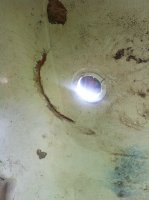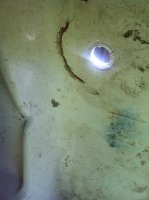My wife was sitting in my new to us sunfish when I noticed all the water in the cockpit quickly drained...
The old metal bailer had pushed up and there is a crack around the cockpit edge. Looks like it did not get much resin in the build process....
I know I need to come from behind but I cannot figure out where to put an inspection port in or how to tackle.
Was going to just fill the slit with marine tex.... or thought to start stuffing it with fiberglass fill so it touches the bottom and adds support. No hull number so I am guessing a dreaded 72

The old metal bailer had pushed up and there is a crack around the cockpit edge. Looks like it did not get much resin in the build process....
I know I need to come from behind but I cannot figure out where to put an inspection port in or how to tackle.
Was going to just fill the slit with marine tex.... or thought to start stuffing it with fiberglass fill so it touches the bottom and adds support. No hull number so I am guessing a dreaded 72



